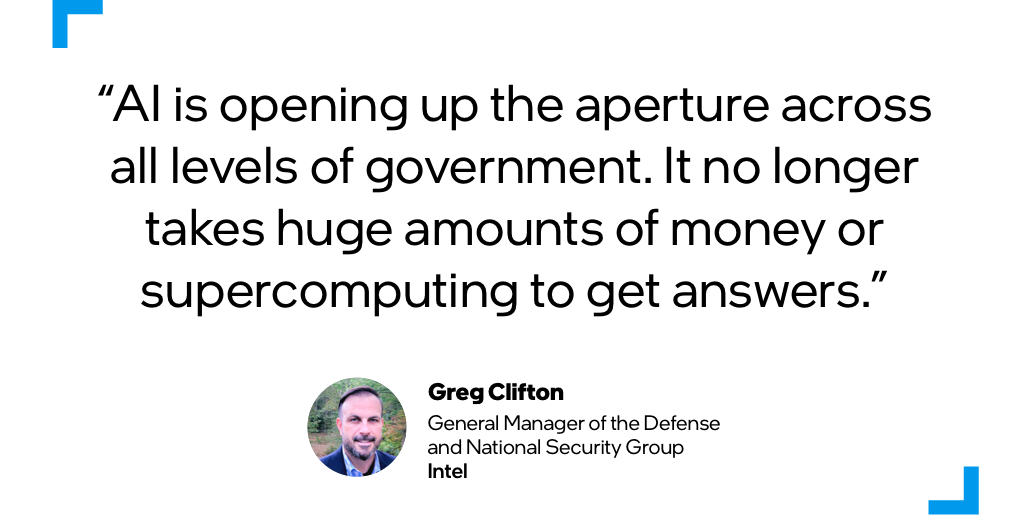Before Governments Can Unlock the Full Potential of AI, They Need to Get the Data Right
Federal and state agencies are sitting on a mountain of information that could improve the lives of citizens—but only if they’re equipped to harness it.
Accelerated medical research that identifies cures faster than ever before. Critical infrastructure that diagnoses and fixes breakages before they happen. Expedited citizen services that speed up delivery of licenses, tax refunds and government loans.
Artificial intelligence may exist in the digital realm, but it will reshape society as we know it—determining the destinies of communities and countries alike.
AI could automate 1.2 billion US federal government working hours annually, according to Deloitte. Recognizing the technology’s promise, governments around the world are already tapping into AI’s analytical capabilities to streamline everything from immigration visa processing to income tax filings.

The US government has disclosed 700 AI programs in place across federal agencies, including a partnership between the FBI and Intel to help find missing children by analyzing high volumes of tips from the public, and an Intel initiative with DC Water that automates inspection across 1,800 miles of sewer pipe.
“We’re going to see AI used a lot more in logistics and planning, whether that’s in the defense space—moving people, moving things like food, gasoline and munitions around the world—or sourcing a critical component in the government’s supply chain, like semiconductors,” says Greg Clifton, General Manager of the Defense and National Security Group at Intel.
The public sector is well placed to take advantage of recent innovations in AI, as government agencies are flush with data: health data, tax data, intelligence data, citizen’s services data. The challenge, says Clifton, is leveraging this data into something actionable.
Making data work for society
Agencies aren’t ignorant of the treasure trove of intelligence they’re sitting on; nearly all US government agencies employ chief data officers. Until recently, however, extracting insights and solutions that could benefit both citizens and government agencies demanded computing power that only a supercomputer could offer, and only well-funded agencies could afford.
Today, the rapid evolution of AI is changing the game, to where even small organizations are able to use data more effectively.

Intel has a history of helping governments with their complex computer needs, whether via on-premise supercomputers or off-site at the edge. As technology evolves, agencies are increasingly relying on Intel’s broad compute portfolio, which includes CPUs, GPUs, FPGAs and—increasingly—AI accelerators.
While there is a lot of excitement in government over what AI can deliver, Clifton urges agencies to not rush in before they’ve taken a thoughtful approach to their AI strategy. Although they may not realize it, many in the public sector already have the infrastructure in place to prep their data ahead of training an AI model.
“We spend a lot of time with agencies just helping them get there, letting them know that they don’t need to go out and spend a lot of money on accelerators up front,” says Clifton. “A lot of their data is already sitting on standard servers running on Intel, which they can leverage for the first stage of AI.”
Agencies also need to be strategic about how they want to utilize their data, and what specific job they want their AI model to accomplish.
“Make sure you build smart, rather than buy a bunch of tools that your data is not even ready to utilize,” advises Clifton. “Sometimes going a little slower allows you to move faster down the road.”
AI at the edge
The latest push in AI is happening at the edge, on devices like sensors and PCs rather than in central cloud data centers, allowing agencies to rapidly analyze massive amounts of data and recommend solutions in real time.
AI at the edge also means agencies don’t need to rely on a remote server to transfer information—an essential security consideration for the intelligence community, the Pentagon and other departments that handle sensitive data.
Combining edge computing with new generative AI capabilities creates opportunities for government agencies to innovate as these models become more sophisticated. Clifton anticipates that the next iteration of AI will include better object detection—an essential component of automated driving—and supercharged automation, which can reduce bureaucratic slowdowns. In an automated world, passports could be renewed in seconds, and citizens could get refunds shortly after hitting “send” on their tax returns.
“To take advantage of this really cool technology that could change lives, we’re going to have to make the organizational changes,” says Clifton, noting that software companies have to rethink how they write and deploy software for governments as they adapt to AI—something Intel aims to get ahead of by building specific AI-enhanced data processing accelerators into its compute engines. “My hope is that governments will see this as an opportunity to take a big leap and get ahead of the curve, to be a real driver for change.”
Notices & Disclaimers
Intel technologies may require enabled hardware, software or service activation.
No product or component can be absolutely secure.
All product plans and roadmaps are subject to change without notice.
© Intel Corporation. Intel, the Intel logo, and other Intel marks are trademarks of Intel Corporation or its subsidiaries. Other names and brands may be claimed as the property of others
